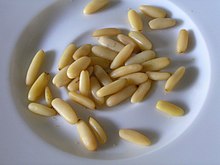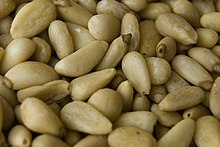Our website is made possible by displaying online advertisements to our visitors.
Please consider supporting us by disabling your ad blocker.
Pine nut



Pine nuts are the edible seeds of pines (family Pinaceae, genus Pinus). About 20 species of pine produce seeds large enough to be worth harvesting. Other pines have edible seeds too small to be useful as a human food.[1][2][3]
Pine nuts have been eaten in Europe and Asia since the Paleolithic period. They are often added to meat, fish, salads and vegetable dishes or baked into bread. In Italian they are called pinoli. They are an essential part of Italian pesto sauce.
Pine nuts can be pressed to extract pine nut oil, which is valued for its mild, nutty flavour. The large edible seeds of the Southern Hemisphere conifer genus Araucaria produce nuts rather like pine nuts.
- ↑ Farjon A (2005). Pines: drawings and descriptions of the genus Pinus. Koninklijke Brill. ISBN 90-04-13916-8.
- ↑ Lanner RM (1981). The Piñon Pine: a natural and cultural history. University of Nevada Press. ISBN 0-87417-066-4.
- ↑ Lanner RM (1981). Made for each other. a symbiosis of birds and pines. Oxford University Press. ISBN 0-19-508903-0.
Previous Page Next Page


